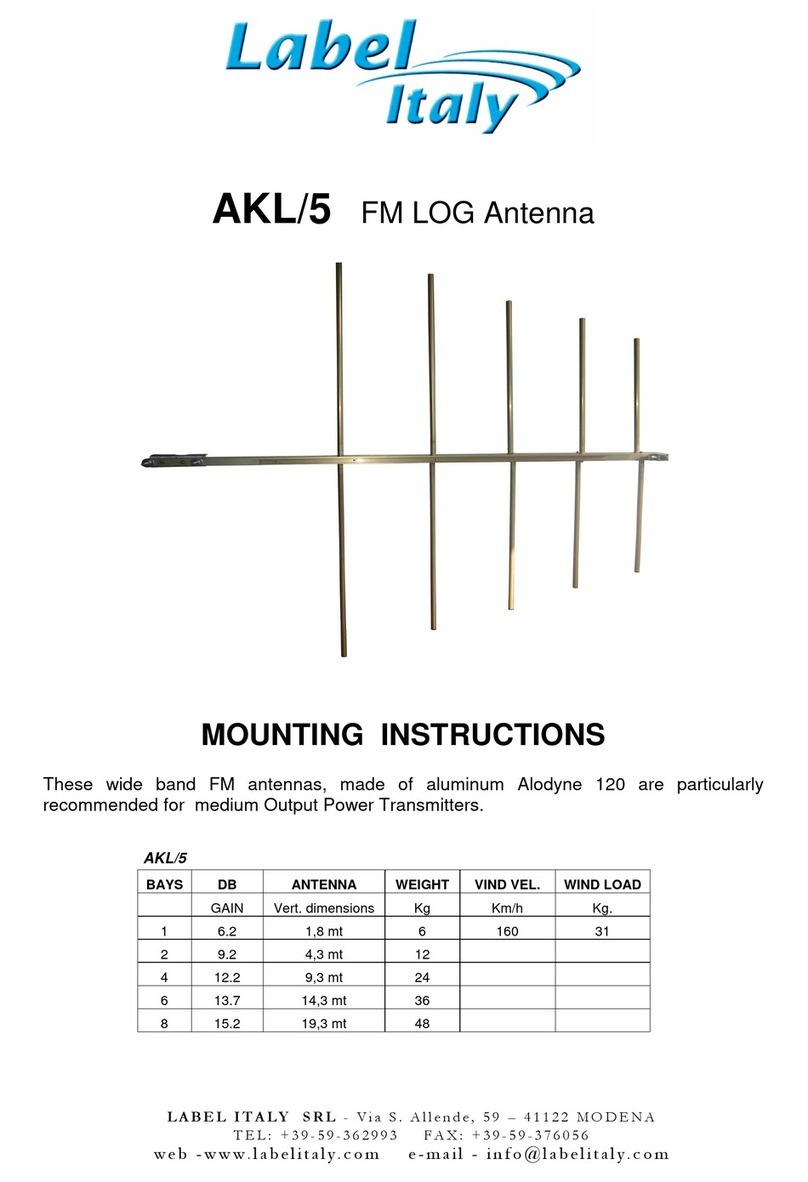
2
------------------------------------------------------------------------------------------------------
L A B E L I T A L Y S R L - V i a S . A l l e n d e , 5 9 – 4 1 1 2 2 M O D E N A
T E L : 0 5 9 / 3 6 2 9 9 3 A X : 0 5 9 / 3 7 6 0 5 6
P . I V A 0 2 5 7 8 7 5 0 3 6 2 C a p i t a l e S o c i a l e 3 2 . 5 0 0 E u r o
w e b - ww w . la b e l i t a ly . c o m e - ma i l - i n fo @ l a b e l it a l y. c o m
WARRANTY
Label Italy Srl warrants each new product manufactured to be free from defects in material and
workmanship and agrees to remedy any such defect, or to furnish a new part, in exchange for any
part of any unit which under normal installation, use, and service discloses such defect within 1
year from the date of purchase by original owner. This warranty does not extend to any of our
products which have been subjected to misuse neglect, accident, incorrect wiring, improper
installation or to use in violation of instruction furnished by us. Nor does it extend to units which
have been repaired or altered outside of our factory nor to accessories used therewith not of our
own manufacture. Label Italy reserves the right to make any changes deemed necessary or
desirable without advance notice incurring any obligation to make like changes in units previously
manufactured or sold. This warranty does not cover transportation or installation cost that may be
incurred. Label Italy’s sole liability is the remedy of any defect for 1 year. Label Italy is not
responsible for personal injury or property damage resulting from improper or careless installation
or usage not intended by the manufacturer. No person is authorized to assume for us any other
liability in connection with the sale of our product. You must furnish model code, serial number,
date, place and proof of purchase. Such as a copy of the sales receipt to establish warranty. Your
letter should include all pertinent details along with part or item serial number involved. Do not
return anything until requested to do so.
WARNING
When energized by an RF transmitter, this antenna system will present a high intensity R.F. field.
Care should be taken not to touch the antenna system when energized unless performing touch
test under factory supervision. It is not advisable to remain near the antenna for extended periods
of time while the antenna system is energized. All the maintenance or repairs should be done with
the transmitter switched off . If the antenna is not pressurized, condensation can occur inside the
antenna harness resulting in possible failure of the antenna.
LIGHTNINGS - ORIGINS AND PROTECTION CRITERIA
The violent and timely atmospheric perturbations, in which electrical phenomena are involved,
such a lighting strokes, have an important influence on the choice of the site in which the
transmitting station will be created. In the low part of the clouds, there is an important quantity of
negative loads, while in the upper part there is the same quantity of positive loads. When the
ionization of the surrounding air reaches some critical values in the low part of the cloud, a
discharge towards the earth is developed, and determines an elevating counter-discharge that will
intercept the descending discharge. The ground draining of the electrical loads enable the passage
of a current pulse that goes from a value of a few KA to several thousands of KA with an intense
electrical field that reaches 300.000 Volt/m: such a passage represents the visible part of the
lightning stroke, which can be one Km long if the discharge happens between the cloud and the
earth. On very high structures, especially if they are situated in dominating positions such as radio
and television transmitting installations, during the storm perturbations some over-tensions that
create real elevating discharges can be observed.
One must keep in mind that during the discharge phenomenon there can be some clouds which
are electrically loaded and which have not already found their discharge channel ; these positions
consist of materials that are good electric conductors and that because of its nature the lightning
stroke chooses the way that presents the lowest electrical resistance.
One realizes the importance and delicateness of the problem and the resolution of the lightning
themselves. The lightings phenomenon depends much on probability, and as a consequence, one
can never have the absolute and guaranteed certainty to be protected. One should not protect all
the positions without any discrimination, but protect the positions that could be touched more easily
in reason of the geographical characteristics of the terrain.































